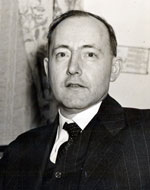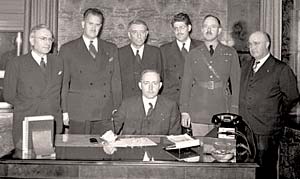The Council Comes to Life
Oregon Governor Charles A. Sprague dragged his heels creating a state defense council. Early in 1941 an Oregon Journal editorial writer noted that 35 states had formed defense councils of one sort or another. Moreover, he claimed that states with defense councils appeared to do better at attracting defense jobs. Sprague delayed action for several months. His natural inclination was to resist setting up more government bureaucracy but pressure was mounting. Finally, on June 1 he relented and signed an executive order creating the Oregon State Defense Council.
Footnote
1 Actually, Sprague recreated the council, since during World War I the State Council of Defense for Oregon played a prominent role in the home front effort before it was dissolved after the war. (Find more information in
Oregon at War: World War I and the Oregon Experience.)
 Governor Sprague reluctantly formed the state defense council. (Photos, Gov. Sprague Records, OSA)
Governor Sprague reluctantly formed the state defense council. (Photos, Gov. Sprague Records, OSA) The governor named Jerrold Owen as state defense coordinator, answering directly to Sprague who retained the title of director. He appointed 26 council members to represent sections of the state and segments of society, including labor, veterans, women's clubs and civic organizations. Sprague noted that "as the war emergency tightens, our loads are bound to increase." The council, he said, would reflect public opinion and provide him with sound advice.
Footnote
2 Organization and Responsibilities
Meeting ten days later, the council set about organizing the state as efficiently as possible. While other western states created independent city defense councils, Oregon settled on counties as the best level to base local administration. Later experience showed the wisdom of the decision as some states suffered with delays and coordination problems associated with too much decentralization. Governor Sprague appointed county defense councils based on recommendations from county courts. Each county selected a chairman and vice chairman and appointed a county coordinator as administrative officer. The State Defense Council adopted a policy of dealing only with county defense councils, not directly with each city or town, thereby avoiding "confusions and irritations" and maintaining a chain of authority.
 The Oregon State Defense Council meeting in executive session Dec. 7, 1941. Members standing from left to right: Robert H. Baldock, State Highway Engineer; Jerrold Owen, State Defense Coordinator; Charles P. Pray, State Police Superintendent; David Eccles, Executive Secretary to Governor; Colonel Elmer V. Wooton, Acting Adjutant General; Brazer Small, representing Joseph Carson of Portland; and Governor Charles A. Sprague, seated.
Enlarged image courtesy Ben Maxwell collection.
The Oregon State Defense Council meeting in executive session Dec. 7, 1941. Members standing from left to right: Robert H. Baldock, State Highway Engineer; Jerrold Owen, State Defense Coordinator; Charles P. Pray, State Police Superintendent; David Eccles, Executive Secretary to Governor; Colonel Elmer V. Wooton, Acting Adjutant General; Brazer Small, representing Joseph Carson of Portland; and Governor Charles A. Sprague, seated.
Enlarged image courtesy Ben Maxwell collection. The State Defense Council sought to provide for the organization and training of civilian volunteers to meet the threat of enemy attack; provide information and direction for the county defense councils; and serve as a screen between the federal Office of Civilian Defense and the county defense councils. Once the county defense councils were created, the state council provided instructors who traveled to each county to set up training programs customized to individual county needs. Regional training schools set up by the Army and the federal Office of Civilian Defense also contributed. By its peak in early 1943, the program had trained nearly 100,000 Oregonians associated with civilian protection programs.
Footnote
3
In June 1942 the State Defense Council changed its organizational structure to conform with federal Office of Civilian Defense guidelines. Essentially, this set up two major divisions centered on civilian protection and civilian war services. Civilian protection, with such efforts as aircraft warning and blackouts, saw the most attention until the threat of attack diminished in 1943. Still, war services efforts related to rationing and salvaging played an important role in the darkest early days of the war. The state council tackled other responsibilities as well. These included playing a big part in the coordination of public relations efforts in newspapers, magazines, the radio, and public speakers. And rumor control was an important focus, especially early in the war. Later, the Oregon Legislature passed the Oregon Civilian Defense Act of 1943 that codified the authority previously based on executive order and granted more power to the governor to defend against an enemy attack.
The Eternal Pecking Order
Generally, the state council operated effectively during the course of the war but suffered its share of frustrations and growing pains. Not surprisingly, council dealings with the tangle of federal agencies resulted in friction. County defense programs also presented challenges to the small staff of the State Defense Council.
Relations With the Federal Government
Relations with the federal Office of Civilian Defense followed a largely cordial and positive pattern but at times state officials couldn't hold their ire. For example, in the midst of reorganization to conform with federal "peremptory guidelines" Governor Sprague lamented to OCD head James (Dean) Landis: "...we rapidly are getting fed up with the imperious, domineering attitude of the sectional and regional offices which lack information on local conditions and apparently are utterly incapable of evaluating the importance of various matters on which action is requested."
Sprague complained that "we are told bluntly that unless we create a flock of useless jobs to deal with a vague program of coordination...that OCD will move into Oregon...and take over the operation of civilian defense in this state."
 Sprague memoFootnote
4
Sprague memoFootnote
4
Some ruffled feathers were smoothed after Oregon defense council coordinator Jerrold Owen attended a conference with Landis in Washington D.C. Owen voiced 11 numbered complaints to Landis at a meeting later recounted in a report to the governor. These included:
 This administrative staff symbol was one of dozens of civilian defense insignia used across the country. (Folder 18, Box 34, Defense Council, OSA)
This administrative staff symbol was one of dozens of civilian defense insignia used across the country. (Folder 18, Box 34, Defense Council, OSA) "2. A minimum of reports and drastic simplification of the same. Civilian defense executives are busy men and women. (Landis said new simplified reports were under preparation).
3. Elimination of the 'gas mask hysteria', galloping jitters and cries of 'wolf! wolf!' (with this Dean Landis thoroughly agreed).
...8. Recognition of state sovereignty and the ability of states to handle defense problems without federal wet nursing and dictation. (Landis nodded his head in agreement on this)."
 Owen memo to SpragueFootnote
5
Owen memo to SpragueFootnote
5
Landis later said he "had no desire to do aught [other] than cooperate fully" and blamed an OCD regional official who "is inexperienced and assumes too much authority."
 Landis telegramFootnote
6
Landis telegramFootnote
6
Owen summed up the conference by reporting all points of disagreement had been ironed out. And, while the usual bureaucratic friction between federal and state officials persisted throughout the war, major disagreements were the exception.
Relations With County Defense Councils
Just as the federal bureaucracy gave the state defense council fits, so did county defense councils. County officials complained about the state red tape and excessive paperwork. They also tried to drag the state defense council officials into local squabbles and personality conflicts.
 William Penn Lewis was awarded a Distinguished Service Cross in World War I. His civilian World War II service in Tillamook County earned less praise. (Folder 14, Box 20, Defense Council, OSA)
William Penn Lewis was awarded a Distinguished Service Cross in World War I. His civilian World War II service in Tillamook County earned less praise. (Folder 14, Box 20, Defense Council, OSA) An incident in Tillamook County grew into a larger story covered by newspapers statewide in May 1942. As often was the case, it hinged on control and turf. William Penn Lewis, the Tillamook County Defense Council chairman, by most accounts had an abrasive and outspoken management style. In typical fashion, he fired Tillamook Mayor Dave Steinbach from his position as chief of public works services for the defense council. Lewis charged Steinbach with "inefficiency, total lack of cooperation, and [a lack of] co-ordination" in relation to defense council offices and a defense control center housed in the city hall. Lewis called the place "dangerously unsafe and unfit for human beings to occupy." He added that the floor of the control center "sags at least six inches." Not content to attack only the mayor, Lewis lambasted two county commissioners for failing to provide adequate funding for civilian defense work. At the same time, he praised the county defense council under his leadership: "There isn't a better defense organization in the state than Tillamook County."
Amid the ongoing acrimony, Lewis blanketed state and federal officials with long, rambling letters pleading for support. He sent a six-page single-spaced letter complaining to Colonel R.C. Moffatt in the Seattle office of the OCD: "This thing is getting under my skin and if this Commanding Officer [Moffatt] would back me up in what he should know is right I could knock out these damn little politicians in a minute instead of using up all of my energy fighting them." Later in the letter, he seeks sympathy: "My wonderful wife, however, is unable to stand the gaff. She has broken down completely and is now quite ill in bed and it is all due to the fact that she is worrying about me, and is afraid it is going to cause me to have a nervous breakdown."
Footnote
7
With the confrontation growing more malignant through the summer, Lewis alienated most officials in Tillamook County and those in state and federal civilian defense offices. Since Tillamook County was of critical importance in 1942 for coastal defense, exasperated officials probably decided he was more trouble than he was worth. Lewis was "kicked out of Civilian Defense." In his own words: "I was knifed in the back while I was away at school."
Lewis chose to escalate the conflict. He sent state council coordinator Jerrold Owen several long handwritten letters seeking to "refute some malicious propaganda" about him. He also called Owen a number of times and tried to arrange a meeting at Owen's home to "sit down quietly and go over this very bad situation." Lewis capped off his offensive with a twelve-page single-spaced letter to the regional director of the OCD in San Francisco. The diatribe railed against those who conspired against him in Tillamook County:
 Lewis letter
Lewis letter
"These damn rats have made life a perfect hell for my wife and myself."Footnote
8 The struggle continued until Jan. 14, 1943 when Lewis sent a letter to new Governor Earl Snell. After months of sending remarkably long letters, he was uncharacteristically brief: "I hereby resign from the Tillamook County Civilian Defense Council." So ended the era of William Penn Lewis in the defense of Tillamook County. Luckily for officials at the State Defense Council, his story was an exception in otherwise garden variety local intrigue.
Related Documents
 Civil Defense in Oregon, 1944. Folder 18, Box 11, Defense Council Records, OSA.
Civil Defense in Oregon, 1944. Folder 18, Box 11, Defense Council Records, OSA.
 Annual Report of Oregon State Defense Council: Civilian War Services, 1943. Folder 19, Box 11, Defense Council Records, OSA.
Annual Report of Oregon State Defense Council: Civilian War Services, 1943. Folder 19, Box 11, Defense Council Records, OSA.
 Final Report Oregon State Defense Council, 1945. Folder 19, Box 11, Defense Council Records, OSA.
Final Report Oregon State Defense Council, 1945. Folder 19, Box 11, Defense Council Records, OSA.
 Marion County Defense Council Report of County Coordinator, 1943. Folder 11, Box 19, Defense Council Records, OSA.
Marion County Defense Council Report of County Coordinator, 1943. Folder 11, Box 19, Defense Council Records, OSA.
 Jackson County Defense Council...Outline of Duties, 1942. Folder 1, Box 18, Defense Council Records, OSA.
Jackson County Defense Council...Outline of Duties, 1942. Folder 1, Box 18, Defense Council Records, OSA.
Notes